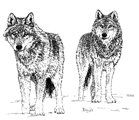Wildlife Damage Management, Internet Center for
Date of this Version
January 2000
Abstract
Gray wolf populations (Canis lupus) were extirpated from the western U.S. by the 1930s. Subsequently, wolves from Canada occasionally dispersed south into Montana and Idaho but failed to survive long enough to reproduce. Public attitudes toward predators changed and wolves received legal protection with the passage of the Endangered Species Act (ESA) in 1973. Wolves began to successfully recolonize northwest Montana in the early 1980s. By 1995, 6 packs lived entirely in northwestern Montana. In 1995 and 1996, 66 wolves from southwestern Canada were reintroduced to Yellowstone National Park (YNP) (31 wolves) and central Idaho (35 wolves). The Rocky Mountain wolf population comprises 3 recovery areas: The Northwest Montana recovery area (NWMT, Figs.1, 2 ) includes northwest Montana and the northern Idaho panhandle. The Greater Yellowstone recovery area (GYA, figs. 1, 4 ) includes Wyoming and adjacent parts of southeast Idaho and southeast Montana. The Central Idaho recovery area (ID, Figs. 1, 3 ) includes central Idaho and adjacent parts of southwest Montana. Wolves in the 3 recovery areas are managed under different guidelines, depending upon their designated status under the Endangered Species Act (ESA). NWMT wolves are classified as endangered, the most protected classification under the ESA. GYA and ID wolves are classified as nonessential experimental populations and managed with more flexible options than the endangered population. The Service believes that 30 breeding pairs of wolves, with an equitable and uniform distribution throughout the 3 states for 3 successive years would constitute a viable and recovered wolf population. If other provisions required to delist are met, primarily adequate regulatory mechanisms in the form of state wolf management plans that would reasonably assure that the gray wolf would not become threatened or endangered again, the Service would propose delisting. It is expected that meeting the recovery goal and delisting will occur within 3 to 5 years.


Comments
This cooperative annual report presents information on the status, distribution and management of the recovering Rocky Mountain wolf population from January 1, 2000 through December 31, 2000. It is also available at http://mountain-prairie.fws.gov/wolf/annualrpt00/.